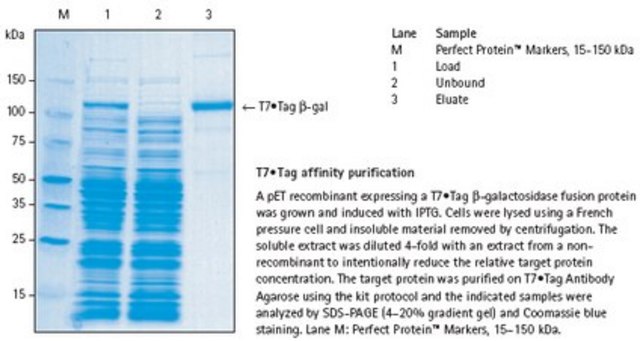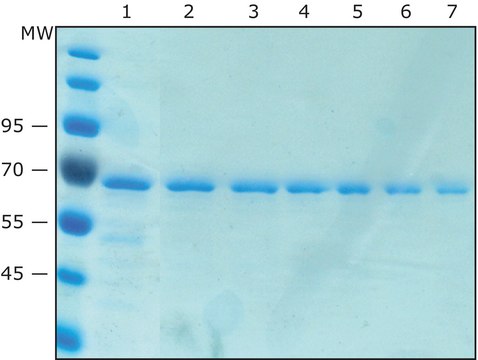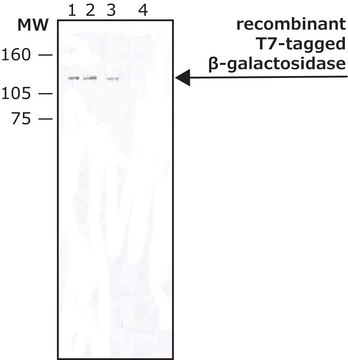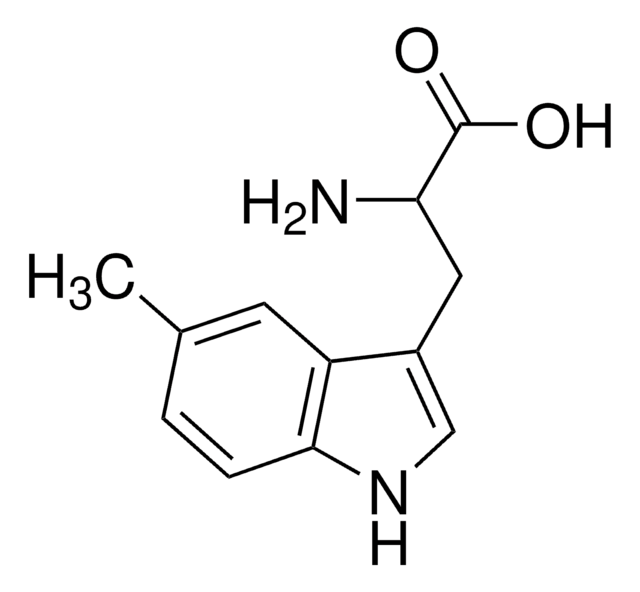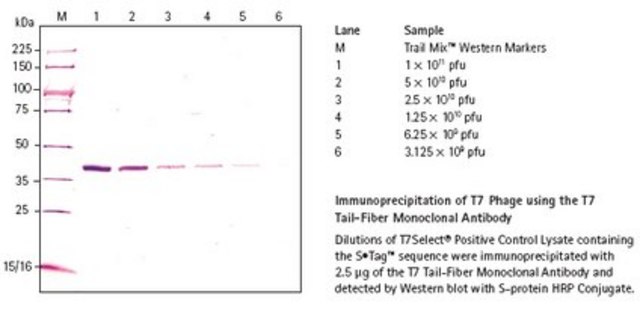Recommended Products
form
liquid
Quality Level
manufacturer/tradename
Novagen®
storage condition
do not freeze
shipped in
wet ice
storage temp.
2-8°C
General description
The T7•Tag Antibody Agarose is designed for rapid immunoaffinity purification of target proteins that carry the T7•Tag sequence (i.e., the amino terminal 11 aa of the T7 gene 10 protein). Purification is based on binding target proteins to T7•Tag monoclonal antibody that is covalently coupled to cross-linked agarose beads, washing away unbound proteins, and eluting at pH 2.2. Capacity will vary somewhat between different target proteins, but the beads are standardized to bind a minimum of 300 µg T7•Tag β-galactosidase per milliliter of settled resin. The beads can be used in either batch or column methods and can be recycled a minimum of five times without loss of binding activity.
Warning
Toxicity: Standard Handling (A)
Legal Information
NOVAGEN is a registered trademark of Merck KGaA, Darmstadt, Germany
T7-Tag is a registered trademark of Merck KGaA, Darmstadt, Germany
WGK
WGK 3
Flash Point(F)
Not applicable
Flash Point(C)
Not applicable
Certificates of Analysis (COA)
Search for Certificates of Analysis (COA) by entering the products Lot/Batch Number. Lot and Batch Numbers can be found on a product’s label following the words ‘Lot’ or ‘Batch’.
Already Own This Product?
Find documentation for the products that you have recently purchased in the Document Library.
Satoshi Hirano et al.
Autophagy, 12(2), 312-326 (2016-02-24)
MAP1LC3/LC3 (a mammalian ortholog family of yeast Atg8) is a ubiquitin-like protein that is essential for autophagosome formation. LC3 is conjugated to phosphatidylethanolamine on phagophores and ends up distributed both inside and outside the autophagosome membrane. One of the well-known
Subhashini Sadasivam et al.
Genes & development, 26(5), 474-489 (2012-03-07)
Cell cycle progression is dependent on two major waves of gene expression. Early cell cycle gene expression occurs during G1/S to generate factors required for DNA replication, while late cell cycle gene expression begins during G2 to prepare for mitosis.
Sara R Heras et al.
Nature structural & molecular biology, 20(10), 1173-1181 (2013-09-03)
More than half of the human genome is made of transposable elements whose ongoing mobilization is a driving force in genetic diversity; however, little is known about how the host regulates their activity. Here, we show that the Microprocessor (Drosha-DGCR8)
Kazufumi Ohshiro et al.
Genes & cancer, 11(1-2), 43-52 (2020-06-25)
Recently, we observed that the TGF-β pathway is altered in 39% of HCCs. The alterations are correlated with a raised HMGA2 level. Therefore, we compared genetic alterations of HMGA2 and 43 TGF-β pathway core genes in HCC patients from TCGA
Andres López-Perrote et al.
eLife, 9 (2020-11-19)
Nonsense-mediated mRNA decay (NMD) is a surveillance pathway that degrades aberrant mRNAs and also regulates the expression of a wide range of physiological transcripts. RUVBL1 and RUVBL2 AAA-ATPases form an hetero-hexameric ring that is part of several macromolecular complexes such
Our team of scientists has experience in all areas of research including Life Science, Material Science, Chemical Synthesis, Chromatography, Analytical and many others.
Contact Technical Service